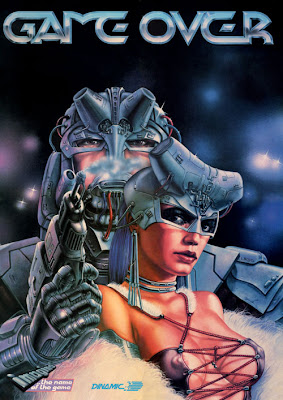
I’ve just driven recklessly through the city streets with the Police hot on my tail, but finally it seems I’ve lost them. I can no longer hear the wail of their sirens and in the top of my screen I can see the stars flashing as my wanted level disappears.
My health is low but I’ve no need to panic; the street I’m now cruising down is known for its prostitutes and my ride is certainly hot enough to attract them over.
A minute later and I’m parked under a large billboard in one of the darker areas of the neighbourhood. The working woman clambers out from her seat and over to mine. She begins to pleasure my character and once she’s finished I pay her; albeit automatically and represented only by my on screen funds depleting.
Her work done, she gets out of the car and starts to walk off in search of more custom. But I don’t want to pay for my health boost. I pull out my gun and shoot her before picking up my money from her blood stained corpse.
The game is of course Grand Theft Auto IV and it certainly stands up as one of the most interesting examples of how both sex and women can be treated in the digital world of video games.
What’s particularly interesting about this scenario is I don’t have the option to not pay the working girl for her services and I can’t rob her either; the only way I can get my money back from her is to violently murder her.
Prostitutes first appeared in the GTA series of games in 2001 when the series made its transition to 3 dimensions. The game was deservedly a smash hit but came under intense criticism from many (primarily non-gamer) institutions because of its violent content. By far the number one compliant was the ability empowered to the player to kill prostitutes.
You are not required to kill the prostitutes and indeed nothing in the game prompts you too either. But whilst the game may not deliberately draw your attention to this kind of behaviour, you are rewarded for this action.
I do find it rather disturbing at the sheer volume of videos and articles you can find about prostitute killing in the GTA games.
Try Googling about the subject and then take a quick look at some of the links available:
“GTA IV prostitutes: How do you kill yours?”
“Where can I kill prostitutes in GTA IV?”
Clearly there are a demographic out there who not only want to participate in the act but find it so entertaining that they spend significant additional time finding new and improved ways to kill them. And of course, make videos to broadcast their achievements.
This raises many interesting questions, not least of which is whether there is, or even can be, morality in this completely virtual environment? It’s is after all a game; no actual person is harmed in any way, unless of course you want to factor in the potential mind of the gamer who is playing.
Now I’m not writing here to condemn; but I am interested in what this type of action says about us as gamers. Picture for a moment the following scenario:
You’re playing GTA IV as per my opening example. Except this time you are giving a detailed, no holds barred running commentary to your Mother. Would you feel comfortable? And do you think she would feel negatively about you or indifferent?
Sex and violence in video games is nothing new although it is an area which (at least in terms of the combination of the two) is touched upon very rarely. One of the earliest and perhaps most well known examples occurs in the Atari 2600 game Custer’s Revenge.
The Cover Art for Custer's Revenge.

Released in 1982 by Mystique, Custer’s Revenge places you in control of a Wild West era General wearing only a hat, bandana and boots. Custer has an oversized appendage which is visibly erect and his goal is to avoid incoming arrows and make it across the screen to where a naked Native American woman (named ‘Revenge’) is tied to a crude wooden pole.
Once there successfully, the General proceeds to rape her and the action starts all over again only with increased difficulty. At its release and to this present day, the game was universally panned both for being poor and for the nature of its content (and rightly so), but is this crude depiction of the rape of a woman actually any worse than the murder of one that sells sex?
The graphics are not as crude as the gameplay premise.

Within the world of GTA IV, the act of sex and violence is not the primary feature of the game playing experience, unlike a game like Custer’s Revenge. But at the same time would we accept GTA IV had we been given the option not to pay the working girl? Is her murder really considered more acceptable than taking the health boost by force? It seems in this instance at least, gamers are saying yes.
Sex within games is not always portrayed violently; but the manner in which it’s commonly used is perhaps questionable. We all know the common term ‘sex sells’ and there’s no doubt this is true, but within the world video games (and more so I would suggest than any other medium) it should perhaps be changed to ‘scantily clad women sell games’.
This is partly based on the long held assumption that most gamers are male despite the fact that recent statistics show that round 30% of all gamers are now female. I suspect it is also due to the high proportion of male developers in the industry but that is somewhat speculative on my part.
My first memories of sex being used to sell games came at quite a young age when I first saw the advert for a game called Barbarian (known as Death Sword in the USA). The game was a one on one fighting game where players fought with swords and despite a lack of rating or any content warning, you could also decapitate the enemy player.
The cover and advertising for the game used well known Page 3 and adult magazine star Maria Whittaker dressed in an extremely skimpy bikini. I’d be lying if I said at the time the advertising alone didn’t make me want the game! Thankfully it was for its time a rather fine game despite the controversy.
Maria Whittaker stars on the cover of Barbarian.

I was not so lucky with my second experience however. Dinamic’s Game Over was a shooter released for a number of 8-bit computers by Imagine. The cover art was by Oliver Frey (well known for his superb artwork that adorned magazines of the day such as Zzap! 64 and Crash) and featured a scantily clad woman whose nipple was exposed.
The game wasn’t that great but the controversy surrounding it however made me want it. This rather tame image (at least by today’s standards) caused so much of an uproar that Frey had to redo the image to remove the offending nipple and even then some retailers placed stickers over that area on the box.
Game Over's controversial nipple.

Back then gaming probably was dominated far more by those of the male gender but despite the increase in female gamers, the portrayal of scantily clad women has risen significantly and not just in the advertising.
Female games characters are now commonly portrayed in scant clothing, with visible knickers and large bouncing busts; Tecmo’s Dead or Alive games perhaps the perfect example.
Indeed their upcoming Playstation 3 game Ninja Gaiden Sigma 2 features a female player controlled character where you can shake the SIXAXIS controller to move her breasts and the video advertising released for the game showcases this feature prominently.
Shake, shake - shake, shake it baby!

Whilst even at 33 I’m as partial to sexy characters as the next man; I’m not really sure I want my partner watching me play a game where I can move the females breasts with my joypad. I mean, what image of myself would I be portraying by engaging in such a pointless act? Are male gamers and developers really that sexually frustrated? And if they are, wouldn’t pornography be more fulfilling?
These days there are a fair few games which feature female heroines; a situation predominantly inspired by the commercial success of Core Design’s Tomb Raider.
Originally released in 1996 for the Sega Saturn and then shortly afterwards for the Sony Playstation and PC; Tomb Raider was a 3D adventure game starring female adventurer Lara Croft.
Lara Croft is best described as the female equivalent of Indiana Jones. Strong, agile and beautiful, Lara is a character who was originally designed to appeal to both male and female gamers alike. During Tomb Raiders final design, Lara’s assets (ok, ok, her breasts) were due to be enhanced by 150% to emphasise her femininity. Apparently a ‘slip of the mouse’ occurred and this figure increased to 250%, something that the original designer Toby Gard later expressed some disdain.
Tomb Raider was a great game and huge hit and Lara with her ‘extended’ assets became a cultural icon. Numerous sequels followed, two movies were made and Lara even had her own official models. The most famous of these models was Nell McAndrew who was famously sacked after posing naked in Playboy magazine as Lara without the permission of Eidos.
Despite Lara’s appeal to some female gamers as a strong female character; many felt that her breasts were just too big and finally in 2005 the developers reduced the size from DD cup to a rather more modest C.
Such was the impact of Lara in popular culture, the story made The Times newspaper and the whole issue still managed to upset some female groups. “It doesn’t make it easier to be a girl in today’s culture,” Deanne Jade, principal of The National Centre of Eating Disorders, said. “Why don’t they make her podgy?”
At the time Matt Gorman (brand manager for Tomb Raider) was quoted as saying “The days of selling Lara as boobs and guns are over.” Somehow though I doubt that’s completely true; perhaps what he really meant is that they will start to try and make decent Tomb Raider games again (which to be fair, I guess they did).
Whilst few, there are some examples of developers trying to maturely portray sex within video games. Take for example Mass Effect, which features a consensual sex scene as part of the main characters development. It’s handled maturely and integrated perfectly into the story rather than simply being a rather degenerate sideshow like the one which can be found in Sony’s God of War.
Despite its mature handling, the scene in Mass Effect still caused an absolute flood of media uproar. This was largely due to the significant distortion of the facts being reported on popular news channels and these themselves were caused largely by Kevin McCullough’s accusations that the game allowed virtual rape with people and species of all genders.
It makes you wonder why games developers even bother trying to tackle sex within games at all given this kind of negative press although in a rather bizarre twist, noted game hater Jack Thompson actually ended up defending Mass Effect at the time. Tis' truly a funny world.
Are the majority of these reactions are caused by gaming’s prior offerings, be it the infamous Hot Coffee mod for Vice City or the prostitute killing in GTA IV? Or is it more how these offerings are presented to us; after all I don’t recall much outrage when Leisure Suit Larry first released despite the highly sexual content. Maybe games simply need to be more upfront about the content.
Would Hot Coffee have been more universally acceptable if it wasn't sneaked in?

Whilst gaming as a media format is now advanced enough to tackle sex in a mature manner; it is perhaps us the gamers that hinder its development.
Scantily clad women with large breasts do seem to make many of us more likely to buy games as does any mention of something controversial; and whilst this trend continues I believe it will always be difficult for developers to get a more realistic design and approach to sex and sexual themes accepted by the majority.
Using Lesbians to sell a game? Not according to the developer; these are just two women who chose to become lovers. Erm...

What worries me is the message we also send out about ourselves and our hobby due to the nature of some of this content. Where exactly are the boundaries? Why are we happy to kill a sex worker but not to display an act of love in an intimate fashion?
Heavy Rain will be the next big hitter to try and tackle sex in an adult manner but whilst I wish it luck I can’t help but think it’s doomed to fail in this respect, at least where the non-gamer is concerned.
Ultimately games need more sex and less sexual violence; but in a pastime that thrives on competition and destruction perhaps there really isn’t really any room for love.

Read more...





















